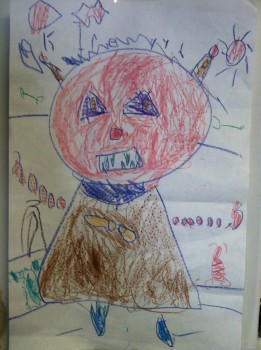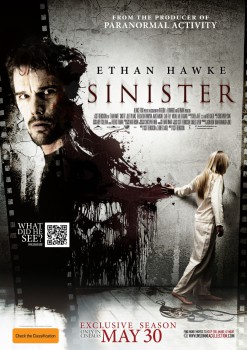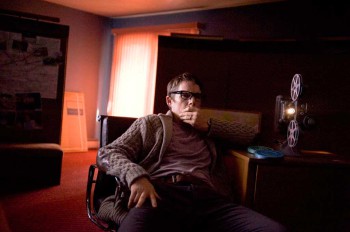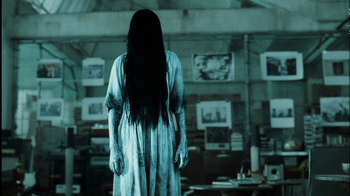Review of Sinister: Is Bagul the New Bogeyman on the Block?

Anyone who has used the search engine Google more than once knows that it automatically generates ads based on your search terms that are then embedded into your search list. Aside from a little yellow “Ad” button, they look deceptively like more search results, tricking the unwary 2-a.m. web surfer into accidentally clicking on them and then being nightmarishly whisked off to some random retail site. The algorithm often creates nonsensical advertisements, proving yet again that we are still a long way off from AI (or even, in some cases, from I).
When I did a search for “Bagul,” aka Mr. Boogie aka ancient Babylonian deity who consumes the souls of children, the following three ads popped up at the end of my first page of hits (actual web links redacted, because I do not want to be responsible for you unleashing Mr. Boogie onto yourself or your family):
1. Bagul Store: Bagul: super cheap Hurry while stocks last!
2. Bagul – 70% Off – Lowest Price On Bagul: Free shipping, in stock. Buy now!
3. Bagul up to 70% off – Bagul sale: Compare prices and save up to 70%
If you’ve seen the 2012 film Sinister, the thought of having Bagul shipped to you for free should be absolutely chilling. Even if he is up to 70% off. Just 30% of Bagul will probably still mean certain death for you and your loved ones. In fact, someone inadvertently clicking on one of these ads could be the premise for Sinister 2, the sequel.
On the recommendation of several people (well, two — but since one of them was Black Gate ed-in-chief John O’Neill, that should count as several), I selected Sinister as my Hallowe’en 2014 viewing. After the last peals of “trick or treat” had long since dwindled away down the dark, cold streets, and our own little homespun Mrs. Munster (yes, that is what my 5-year-old specifically chose to be this year) and zombie cop had been tucked into their beds to sleep off their Hershey/Mars/Nestle comas, my wife and I inserted the Blu-Ray we’d rented into the player. My wife promptly fell asleep, but that has no bearing on the quality of the movie in question. For the next hour and fifty minutes, I was transfixed. I’ve got to concede: for this genre of film, this one is a high water mark.
Interestingly, for the first half hour or so of the film, if you went in “blind,” there would be little tip-off that this is a supernatural horror thriller. The premise could careen in several directions. Ellison Oswalt (Ethan Hawke), a true-crime writer desperately trying to reclaim the past glory of his decade-old bestseller, moves his family into the home of an unsolved murder in which a whole family was drugged and hung from a tree in the back yard. This is to be the subject of his next book, and he will spend the next weeks and months covering all the bases, including ones that the local cops possibly overlooked, in order to produce — as he wistfully opines — his own In Cold Blood (and how many horror films have the chutzpah to work in a Truman Capote reference, I ask you?). Going in mostly unfamiliar with the material, the mind of this viewer was imagining a possible scenario that the killer is still around and will now try to pull off a twofer — a BOGO, if you will — with this new family (oh, and did I mention that stupid Ellison thought it best not to inform his wife and two children that the home they just purchased was the scene of a grisly unsolved multiple homicide?).
 But no! Much better than that, I assure you. [I should mention at this point that there will be RANDOM SPOILERS ahead, peppered throughout the review.] Ellison’s journalistic instincts have deposited him right on the doorstep of a thousands-years-old entity that consumes the souls of children. Top that, Truman Capote!
But no! Much better than that, I assure you. [I should mention at this point that there will be RANDOM SPOILERS ahead, peppered throughout the review.] Ellison’s journalistic instincts have deposited him right on the doorstep of a thousands-years-old entity that consumes the souls of children. Top that, Truman Capote!
Bagul, or Buhguul, is not real, kiddos. That is to say, there is not an exact analogue bearing his name in pagan mythology — although there are certain parallels and antecedents like Lilith and Abyzou, according to Internet blogs (the fact that the character has prompted such research in the web-o-sphere is an indication of how damn good a job the writers did conjuring up a new bogeyman).
But the filmmakers have planted just the right amount of texture to give it some feel of credibility, a la The Necronomicon et al. Never existed, but has just the right flavor to dupe some folks into thinking there’s something legit there. This history-flavored backstory is aided and abetted by an uncredited cameo by Vincent D’Onofrio as Professor Jonas, a specialist in occult homicides, who only appears via Skype but adds some quirky gravitas to the proceedings (D’Onofrio is just perfect here — could they have gotten a better actor for that part? No, is the correct answer).
I’m writing this without any knowledge of what other projects director/co-writer Scott Derrickson and co-writer C. Robert Cargill have been involved in, but based on this film I can say they are the real deal. Derrickson has bona fide vision, and some serious chops as a director. And the script by him and Cargill is smart — much smarter than one typically goes in expecting from this genre. Let me just highlight a few things that they got very right, straight from the “This is How Horror Cinema Should be Done” playbook…
Hawke walks an actor’s tightrope here and never falls off: his character, Ellison, is our POV throughout the narrative — and the script holds very tightly to this, indicating that Derrickson and Cargill are of the narratologist school of literary theory — so we have to spend a lot of time with this character. Ellison’s decisions throughout the film are of the sort that will make the audience cringe, yet he holds onto our sympathies just enough that we are rooting for him to have a change of heart, “see the light,” wise up, etc. I can’t speak for everybody, but I found myself rooting for him and his family to the end, while decrying the choices he makes that seem blatantly foredoomed.
Here’s the trick: we all know that age-old jab at horror film formula — you’re yelling at the characters DON’T GO INTO THE BASEMENT and thinking how stupid they are to do so. With Ellison’s character, we see that he knows how ill-advised his choices are, but those choices do not defy suspension of disbelief because they are trumped by a passion that overrides his basic survival instincts: he is driven by a desperate desire to get the scoop, to break the story, to regain the notoriety that he once tasted. Sure, he’s putting himself and his family at risk, but what he sees as his art, his calling, is compelling him to take those risks for the sake of the prize. He almost does the sane, logical thing — like picking up the phone and calling the cops with what he’s uncovered — more than once, but then, to our chagrin, he makes the more bold, foolhardy, bat-guano crazy choice instead, knowing, on some level, how dangerous it is. Misguided, deluded, but also stubbornly falling into the hero archetype that drives most stories, and so we cannot help but be co-conspirators in his quest.
 Through half the running time of the movie, we know that you-know-what is really going to hit the fan when Ellison’s wife Tracy finally learns that her husband has really crossed the line this time, moving her and their son and daughter into the actual home where the horrible murders transpired that will be the subject of his next book. We are not denied that dramatic pay-off, and with Hawke and Juliet Rylance sinking their acting teeth into the dialogue, we get scenes that would have been worthy of a drama in the running for the Oscars. This is material that could fuel a film having nothing to do with the supernatural — a husband driven by his passion to put his family’s needs second; a wife who wants to be supportive but is pushed to the brink in doing so.
Through half the running time of the movie, we know that you-know-what is really going to hit the fan when Ellison’s wife Tracy finally learns that her husband has really crossed the line this time, moving her and their son and daughter into the actual home where the horrible murders transpired that will be the subject of his next book. We are not denied that dramatic pay-off, and with Hawke and Juliet Rylance sinking their acting teeth into the dialogue, we get scenes that would have been worthy of a drama in the running for the Oscars. This is material that could fuel a film having nothing to do with the supernatural — a husband driven by his passion to put his family’s needs second; a wife who wants to be supportive but is pushed to the brink in doing so.
In the commentary, the scriptwriters acknowledge that they drew upon their own lives as writers to round out the character of Ellison, and so, for this writer, Ellison’s impassioned argument to his wife in defense of the sacrifice he is making to pursue his art hits close to home. I have certainly gone through phases like this in my life, where I thought the demands of the material I would produce must outweigh all else. When we become family men, we have to learn to modulate that or else risk failing in our other callings of husband and father. Ellison is the poster boy for the dangers of not achieving that balancing act — a cautionary sign writ in blood.
Bagul — aka Mr. Boogie — is a credible addition to the pantheon of bogeymen: a spirit that gains its access through imagery of its past atrocities. The creators acknowledge that they were inspired by The Ring (2002), or Ringu (1998). Far from being a derivative imitation of those films, Sinister expands upon those metaphysics and creates its own fertile playground of horror.
The whole film hangs together — I didn’t notice any major plot holes or hang-ups. At the same time, it manages to be layered and nuanced. There are brilliant little callbacks: scenes recall earlier scenes in satisfying ways. For instance, the daughter brings her father Ellison a cup of coffee while he is sequestered away in his den working, a loving gesture that her father barely acknowledges, absent-mindedly closing the door on her. Note how another cup of coffee from his daughter at the film’s end will carry profound weight and deliver a wallop. This is just good writing that belies the genre, putting it head-and-shoulders above most film entries in this field.

For another example of how well this narrative is constructed, I submit to you how it all ties together at the end. The film’s ending has been one point of criticism among some fans. Before I extoll the ending, let me address why it feels a bit unsatisfying. First, it happens fast. After an hour and forty-eight minutes of build-up, the entire climax and denouement play out in a couple minutes. This happens because [Again, MAJOR SPOILER here] our POV character buys the farm, quite quickly and suddenly, and in those final couple minutes our POV shifts to the killer (or the acolyte of the real killer, to frame it accurately).
After being so invested in the narrative as it has unfolded through the eyes of Ellison, it is jarring suddenly to lose that perspective, and to be denied any of his thoughts or feelings on the whole matter. This is a practical obstacle, of course — the only way the writers could have delivered some kind of reflection or insight from Ellison on how it all plays out would be some sort of afterlife voiceover a la Kevin Spacey’s character in American Beauty (1999).
But what I have to note about the way the film ends is this: It is a big plot twist that follows so naturally from the rest of the plot that, until I was reflecting on the film afterwards, it didn’t really sink in that it was a plot twist! The twist, readers who have seen the film will know, is that the missing child from each of the murdered families was the murderer (i.e. the physical person who carried out the killings on behalf of the immortal entity). I didn’t see that coming, but it fit in so naturally with everything leading up to it that I didn’t realize I hadn’t seen it coming except in retrospect. Which brings me to the next round of kudos…
Misdirection. Two supporting roles are introduced who muddy the waters of who the killer might be: Fred Dalton Thompson as the sheriff and James Ransone as the deputy. These quirky small-town characters are played like they might have come straight from the set of David Lynch’s Twin Peaks (1990-91). Like many viewers, I wondered if either of them actually had some connection to the killings, while hoping that they didn’t. I was so pleasantly relieved and satisfied that they proved to be “the good guys,” and that their ominous warnings were actually wisdom and not some cover-up for occult connections.
Finally, as horror goes, Derrickson (I said it earlier and I’ll say it again) has some chops. He builds up the suspense, delivers the shocks, and does it all without relying on gore and grue — even while very gory, gruesome events are transpiring. This film joins such classics as the original Texas Chainsaw Massacre (1974) for being so good at cinematographic sleight of hand that you remember more gore than ever actually appeared on screen. The camera cuts away at just the last second, leaving your own imagination to do the dirty work. Case in point: the lawnmower scene, which will likely lurch disconcertingly into my brain the first time I start up my lawnmower next spring. This film does have scenes, man: creepy as hell, spooky, haunting. Like the kid coming out of the box? That’s right up there (and that’s one that comes early in the show, and has a completely naturalistic explanation! If that grabs your attention, just wait until Mr. Boogie starts popping up.)
Sinister inspired io9 blogger Annalee Newitz to opine that it suggested another story beneath or behind it, one that could have been written by Neil Gaiman (how many horror films can one say that about?). You can read her interesting take HERE.
The film did very well, and so, inevitably, a sequel is slated. Here is my prediction: If there is a new director and scriptwriters, it is going to be run-of-the-mill formula that one might as well skip. If, on the other hand, Derrickson and Cargill are again at the helm, furthering their vision, it may well be worth checking out.
If the producers of the sequel really want to take this film in its most logical and intriguing direction, Ransone’s deputy will team up with D’Onofrio’s professor to pursue the case with the new knowledge they have gleaned from their association with doomed Ellison. This, rather than just the same rehashed set-up transplanted to a different family, would be the smart way to go. But I don’t have that much faith in Hollywood, do you?
Sinister: **** (4 out of 5 stars)
Fine review, Nick! And yes, I may never start up a lawnmower again without that nasty image popping into my head (a gruesome, gruesome scene, shot without any gore at all. Marvelous. And awful, in a good way.)
And Irelyn’s Bad Robot is awesome. Is she available for illustration work?
John,
Yeah, but she’s going to be a mean contract negotiator. When I informed her I’d shared her picture on the Internet, her mother immediately had to butt in and say, “Did your daddy ask your permission, and how much is he going to pay you?”
My daughter arched her eyebrow and thought a moment, then said, “Yeah, Daddy, I want seventy-five dollars.”
To which I chuckled half-heartedly, took the laptop and slinked away…
As the other recommender, I’m glad you enjoyed the flick. I think your review was spot on!
There’s so few really good horror movies nowadays that I’m especially keen when I find a good one. Care for a few other recommendations? Try Absentia, Banshee Chapter, and Lake Mungo. All three are low budget horror films. I listed them in, from my perspective, best to least.
James,
I haven’t seen any of those three films, so I will have to add them to my queue. A really good horror movie is a rare gem, indeed.